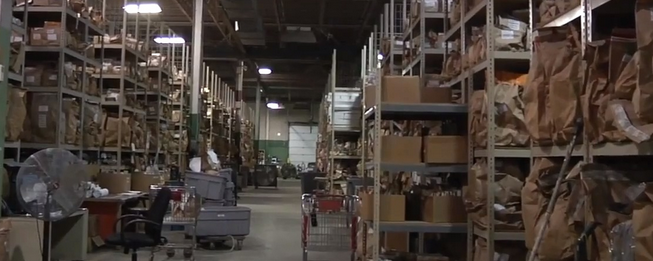Cases where evidence may be compromised include a double sexual-assault trial,
September 13, 2018
Criminal trials may go on hold and attorneys are worrying about lost evidence three weeks after a fire damaged one of the Kansas City Police Department’s evidence storage rooms.
Cases where evidence may be compromised include a double sexual-assault trial, the 2016 Westport shooting that wounded at least six people, and other criminal investigations, defense attorneys told The Star.
“We have got trials set and we have guys sitting in jail for a year,” attorney John Picerno said. “My concern is that they have lost valuable evidence that we can never regain . . . If you have a drug case and they lost the drugs, then it is a huge deal.”
The extent of the damage is unclear, but evidence was destroyed, police say.
Jackson County Prosecutor Jean Peters Baker has been in contact with the Police Department about the fire and said she can’t yet identify which cases are impacted because police crews are also still sorting out the damage.
Still, in some cases, attorneys are complaining that prosecutors are not alerting them that evidence is missing.
The recovery process after the Aug. 23 fire at the Kansas City Municipal Services building at 5300 Municipal Ave. is daunting.
While evidence kept in other police warehouses remains available, all of the thousands of pieces of evidence in the fire-damaged building are not being released while police complete an inventory of the damage, attorneys said.
The police crews recovering the evidence were working with the same diligence as at a crime scene to guard the integrity of the evidence, Kansas City police spokesman Sgt. Jacob Becchina said the day of the fire.
But in this situation, defense attorney Joe Vanover said, “it’s a crime scene of a thousand crime scenes.”
Police have a chain-of-custody process protecting evidence that attorneys rely on, he said, and the incursion of many fire department personnel, while necessary, may make it difficult for prosecutors to assure that integrity in some cases.
The cause of the blaze remains unknown, but investigators have said there are no indications that anyone broke into the building.
Smoke and fire triggered an intrusion alarm at 12:47 a.m. the morning of the blaze and fire crews arrived to find smoke pouring from the building. The fire damage was contained to a small portion of the building, but evidence was destroyed.
Defense attorney Dan Ross told The Star that he is handling at least two cases where evidence appears to be lost or missing. He is concerned that he was not warned by the Jackson County Prosecutor’s Office and that he did not learn about particular missing evidence until he asked to see it. Some attorneys and court officials want the prosecutors to share the inventories police are creating, he said.
He said he plans to go to court to compel the state to disclose where it is aware of lost or damaged evidence.
“The state is obligated under the law to disclose, proactively to the defendant, deficiencies in its evidentiary case,” Ross said. “When physical evidence . . . in possession of the police is now ‘unavailable’ and potentially damaged or destroyed, my client has a right to know.”
Peters Baker, the prosecutor, said her office would provide information on compromised evidence if they had it, but that the Police Department is still gathering information.
“I have spoken to the police department numerous times about the warehouse fire and I believe that they have a very defensible process about how they are going through triaging what they have,” she said. “But as of this moment, I don’t know of any case that has been impacted.”
Becchina said Thursday that the Police Department cannot yet detail the extent of the damage, nor name any affected investigations. But he said information is being shared with prosecutors as it becomes available.
“I know that people from our investigations have been in touch with prosecutors,” he said, “(but) to the extent that any case with any evidence has been affected, I really don’t have that information and I don’t know when we will.”
The building that burned has been in use by the city since 1987. It was formerly a Kenworth truck plant, city spokesman Chris Hernandez said.
One section of the building is modified for exclusive use by the Police Department. Other parts of the building are used by the city for maintenance of large vehicles and radios.
Around the country, police departments often use old warehouses or buildings that were originally designed for other purposes, said Joe Latta, the executive director of the Burbank, Calif.-based International Association for Property and Evidence, Inc.
When police budgets are strapped and politicians face pressure to get more officers on the street, property warehouses tend to be “low on the food chain for getting fixed,” Latta said. “The buildings are usually hand-me-downs, not state-of-the-art with all the alarms. That’s a fact of life.”
Fires in property warehouses are rare across the country, he said.
But when they occur — or, as in New Orleans after Hurricane Katrina, a property room is flooded — recovering the thousands of pieces of evidence “is a slow, tedious project.”
In 2015, the Minneapolis Police Department had 25,000 pieces of evidence and property damaged in an electrical fire.
The fire charred some items beyond recognition and water damage left many more documents and photographs soaked. They required several months to dry out.
The envelopes and bags of evidence, whatever condition they were in, were removed from shelves in order and replaced in the same order in another location on long sheets of paper to dry, said Kirsten Hammarberg, the Minneapolis police property and evidence department’s supervisor.
Immediately, one-by-one, wherever evidence was affected, the staff entered notices into each court case file, digitally and in paper, alerting that there was a concern and giving the department’s phone number. It took a month to get the all the cases identified and notices sent, Hammarberg said.
Damage to evidence included photo lineups, cell phones, knives, wallets and drug paraphernalia, she said. Items such as guns, money, drugs and biological evidence like DNA were kept in separate vaults or coolers.
“It can be devastating,” Hammarberg said. “It can take awhile to get back on your feet.”
In Minneapolis, the department didn’t try to put a monetary value on what was lost. For those victims in cases where justice suffered, Hammarberg said, the loss was immeasurable.



